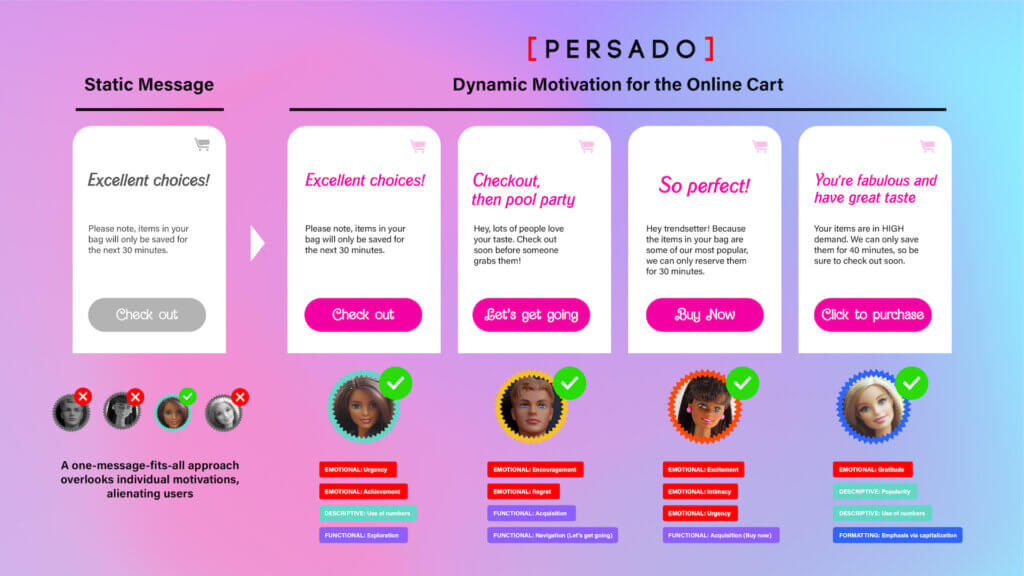August 10, 2023
Conversational Marketing for Enterprise Brands
By Liza Colburn

Modern marketing has evolved from a one-way broadcast into a two-way dialogue. No matter if it’s a loyalty program or conversational marketing, brands want to connect with customers and create long-lasting relationships. There are many different ways brands can do so through conversational marketing. Let’s explore what’s behind this marketing strategy.
What is conversational marketing?
Conversational marketing refers to marketing strategies that engage customers in a two-way dialogue. Popular forms of conversational marketing include live chat, chatbots, and social media. There are also other forms as well, such as personalizing messaging, product quizzes and guides, user-generated product reviews, and word-of-mouth marketing.
What makes conversational marketing effective?
Curiosity, community, and collaboration make conversational marketing effective. The most successful conversational marketing campaigns strike consumers’ curiosity so much that they are naturally inspired to talk about it or post about it on social media. Conversational marketing also drives or builds on a sense of community between customers, who should feel like they are part of the campaign and connected to the brand and/or brand community. Brands engaging in conversational marketing collaborate with customers and sometimes other brands to build that sense of belonging.
One way brands can create this feeling of a connected community is through quick and thoughtful responses to customers’ questions through live chat and/or social media. Another is by creating a platform for customers to play off of each other to continue the conversation, without direct involvement from the brand.
What are the types of conversational marketing?
Conversational marketing can encompass everything from brands sending direct messages to customers via live chat, social media messaging, or another direct message channel to less direct strategies that are just as effective in driving conversation. Conversational marketing can mimic the in-store experience or act more like a pop culture movement with the brand at the center.
Live chat
Chatbots or a combination of chatbots and human agents engaging with customers and answering questions in real time has long been associated with customer service rather than marketing. However, as brands became more digital, they began to embrace the omnichannel customer experience. Within this model, marketing and customer service aren’t as separate as they once were. Now, marketing and customer service are quickly merging under the customer experience umbrella.
When it comes to the customer experience, brands positioned for growth are becoming more proactive than reactive. That’s where Generative AI for the customer experience comes in. Brands want to recreate the in-store experience online. But, with customers shopping online 24/7, it’s impossible to staff live chat around the clock. AI-powered chatbots changed the game for chatbot marketing, allowing companies to engage with customers around the clock in unique ways, answer customers’ questions, and gain valuable insights. In addition to website live chat, AI chatbots can be used to connect with customers in real time across Messenger by Meta, Twitter Direct Message, Instagram Direct Messenger, and more. The conversations will vary based on the channel.
AI chatbots + humans = better customer experience
While AI chatbots answer customer inquiries at scale, they still need humans to train them and customer service agents to answer more complicated questions and to take feedback from customers to improve the overall experience. While it might be possible to fully automate customer service, it’s not advisable to do so as it doesn’t lead to the most engaging customer experience. It’s best to have the bots handle repetitive tasks, while humans take over more complex tasks. If bots (or humans) are just deflecting customer inquiries, they are likely to frustrate customers, causing them to go elsewhere. When humans and chatbots work together to solve customer problems, great conversational marketing comes to life.
For example, Hyatt’s chatbot responds in seconds and is both helpful and conversational. Since almost 50% of customers will navigate away from live chat if they don’t receive a response within a minute, instant responses are vital to chatbot marketing.
Overall, the best chatbot marketing strategies are proactive rather than reactive. These channels aren’t just for answering customer service questions. Speaking to customers directly gives brands the chance to close sales, upsell, and drive more customer loyalty.
Social media
Social media is perfect for conversational marketing. Over the last decade, brands have used social media to showcase their unique “personalities” and create connections with customers in new ways. While social media is also a customer service channel where customers can get answers to questions via direct message, there’s more to the conversation than DMs.
Everything about social media marketing is conversational. Brands can start discussions on new products, collaborate with influencers, comment on and share customers’ posts, create hashtags so customers can find one another, inspire customers to share their outfits, home decor, or how they use the brand’s products, and more. There are even social media holidays that brands invent and capitalize on.
Check out these winning social media campaigns and their results.
Personalized messaging in the online cart
The online cart is not only the place where sales take place, but it’s also a key opportunity for brands to be more conversational at the moment it matters most. Many brands invest heavily in making most of the digital shopping experience personalized and conversational, yet ignore the online cart. When a customer goes to the checkout counter in-store, the store associate behind the counter doesn’t say the exact same thing to every customer. Yet, that is precisely what brands are doing online with static and unengaging messaging in the online cart.
Persado enables a different approach with Dynamic Motivation. Persado Dynamic Motivation uses session data along with the Persado Motivation AI knowledge base–built on 10+ years of proven marketing communications– to serve personalized messaging to customers in the online cart based on their purchase history, browsing behavior, preferences, and more.
While this may not seem conversational on the surface, customers “converse” in many ways, including with their online behavior. Brands that respond accordingly increase market share, reduce cart abandonment, and improve the customer experience in a way that distinguishes the brand in the market. Brands that apply Dynamic Motivation to the online cart potentially see a 3-5% increase in incremental revenue.

Dynamic Motivation doesn’t just improve the brand’s abandoned cart recovery rate. It can also be used across the entire website and email.
Explore more shopping cart abandonment tools.
Product quizzes and guides
When customers come to an e-commerce store, they often don’t know what to buy. They may want to buy hair products, makeup, a mattress, etc. but have no idea which product is right for them. Which shampoo is best for color-treated hair? What size apparel should they buy? Which mattress works for side sleepers? If they don’t get an answer that makes them confident in their purchase, chances are they will leave the website without converting. While in a store, associates can help guide customers to the right products. But, the same isn’t inherently true online.
Brands can recreate this in-store conversation online through product quizzes, size guides, and more. This helps overwhelmed customers confidently find and buy the products they are looking for. These conversational marketing strategies save customers time, help brands increase conversion rates, and deter frustrated customers from either abandoning the purchase or buying the wrong items and returning them. And can be supplemented with live chat.
MAC Cosmetics provides a Virtual Try-On tool that allows customers to see how a foundation shade looks on their skin before they buy it. This mimics the in-store experience with a makeup artist matching a customer with the perfect shade and recommending corresponding products.
User-generated product reviews
“Social proof”, or the opinions of other buyers “like me.” can be a deciding factor in whether a new customer makes a purchase. Product reviews are a key aspect of conversational marketing and abandoned cart recovery. While good reviews have the ability to sway sales, an inspiration gallery of reviews accompanied by photos of real customers wearing or using the products is even better. Brands that consistently source high quality reviews increase conversions and can better educate customers on sizing, style, and product expectations. This is particularly impactful in the fashion, beauty, and home industries.
Note: Bad reviews are still an opportunity for brand growth. Brands should respond to them to learn and potentially earn another opportunity to improve the customer experience.
Word-of-mouth marketing
Word-of-mouth marketing involves the brand facilitating a conversation about the company’s products or services among friends, family, and the general public, whether in real life (IRL) or on social media. While it is a marketing category all its own, it’s also a conversational marketing tactic. Word-of-mouth marketing has been around long before social media. When it hits the mark, it is one of the more effective forms of marketing, as 88% of consumers trust their friends’ recommendations over traditional media.
Netflix recently shifted their social media resources from Twitter and Instagram to TikTok with the “What Would Wednesday do?” campaign. Wednesday’s arm-jolting dance soon went viral on TikTok. The campaign also included corresponding outdoor advertising on billboards and in airports with silly adaptations of the “What would Wednesday do?” slogan. The show Wednesday soon became the second-most-watched English-language series on the streaming service thanks to word-of-mouth marketing.
The role of brand collaborations in word-of-mouth marketing
One recent example of excellent word-of-mouth marketing can be seen in the super viral conversation around the Barbie movie. This summer blockbuster has the world seeing pink as Mattel begins its strategic transition from a toy company to an IP company.
#BarbieMovie has been used over 9 billion times on TikTok as fans share their pink outfits, thoughts and parodies on the film, recipes and designs inspired by the movie, and more. Other brands are also getting in on the fun with Barbie-themed brand collaborations across fashion, beauty, home decor, and even toothpaste.
- Airbnb listed Barbie’s iconic Malibu DreamHouse.
- Pinkberry introduced a new frozen yogurt flavor called Barbie Land Berry Pink.
- Cold Stone also has a Barbie flavor known as Pink Cotton Candy.
- The Barbie x Ruggable Collection makes it easy for everyone to turn their house into a Barbie dream house with bright and joyful rugs.
- NYX Cosmetics released a makeup collection of Barbie Land colors complete with a Barbie flip phone mirror.
The brands that took on Barbie collaborations helped the virality around the Barbie movie grow exponentially as people shared photos of their Barbie merchandise and outfits across social media. They also benefited greatly from all the buzz around Barbie. In fact, many of these collaborations have sold out or are close to it.
This success shows that word-of-mouth marketing campaigns don’t have to be centered around just one brand. When it makes sense, other brands can also get in on the strategy through licensing deals or other partnerships and help add fuel to the fire.
What are the benefits of conversational marketing?
Conversational marketing feels more authentic and organic than traditional marketing. So it’s no wonder customers respond so well to it and even want to be a part of the campaign themselves. Conversational marketing not only brings customers together with each other and customers and brands together, but it also blurs the lines between marketing and customer experience, marketing and UX, and marketing and product development/design. True conversational marketing is only possible through both internal and external collaboration.


